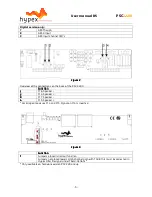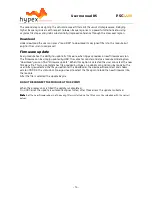
User manual R5
PSC
2
.
400
- 12 -
Perform impulse response measurements for each driver separately. Save the entire impulse record –
truncation can be done later on the filter design program.
Measuring using an external amplifier
A separate amplifier may also be used for measuring the drivers, provided the amplifier’s output
impedance is as low as the DSP unit’s.
Importing response data
Select the tab for the channel you want to import and click “select”. The filter designer expects the
impulse response measurement as a text file with one sample per line.
There is no restriction on the absolute gain of the impulse response data. The only thing that mat-
ters is that the absolute gain be the same for all three measurements. The filter designer computes a
gain offset based on all loaded responses to centre them collectively on the vertical scale.
Truncating response data
Switch to the impulse or step response graph.
Figure 11
The first echo is apparent at 5ms. Zoom in until you see only the anechoic portion of the impulse
response. Dragging the mouse, left-button down, from left to right marks a zoom area. Dragging
from right to left zooms out. Dragging with the right button down pans the plot left and right.
Figure 12
Click “truncate”. Anything currently outside the display is drawn in grey and not processed. You will
notice that in the frequency graph a portion of the low-frequency response is also drawn in grey.
This is to remind the user that insufficient information is available to make *any* correction below



















